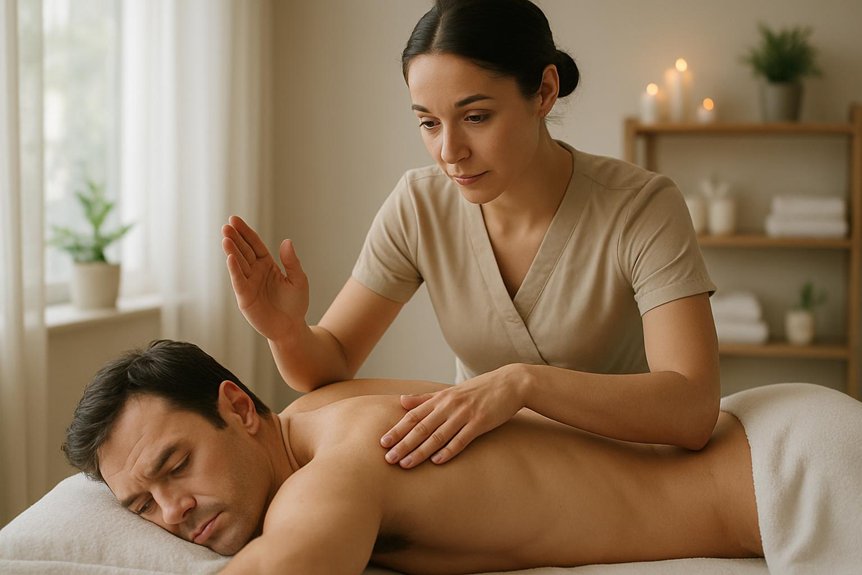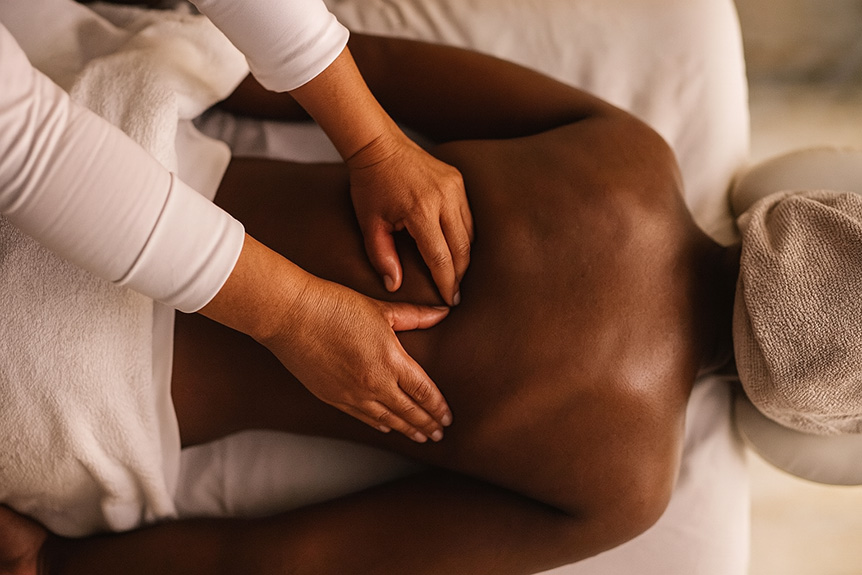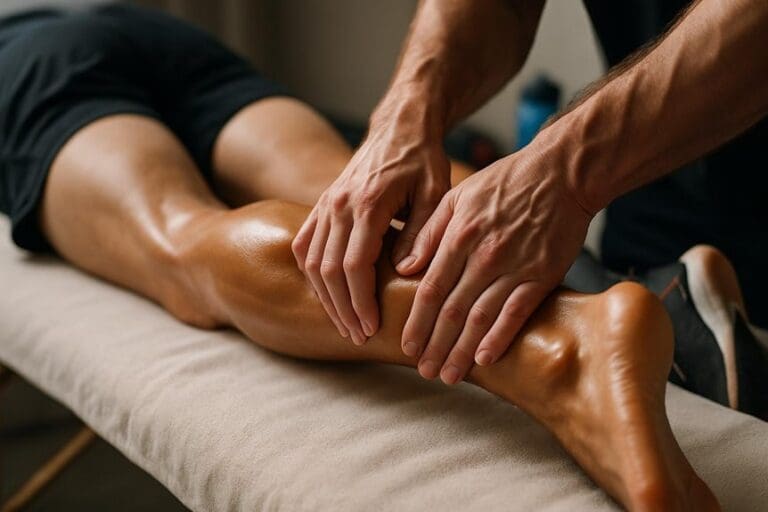It uses firm, targeted pressure to address chronic muscle tension and adhesions. Some discomfort or mild soreness is common, often described as a “good hurt,” but the sensation should remain manageable and is part of the therapeutic process. Effective communication with a skilled therapist guarantees pressure is tailored to individual tolerance, minimizing pain while maximizing results. Temporary tenderness may occur, but most clients feel relief and improved mobility. Those interested can discover effective ways to enhance comfort and recovery next.
Understanding the Techniques

Deep tissue massage employs targeted techniques designed to reach deeper layers of muscle and connective tissue, effectively addressing chronic tension and restricted movement. Therapists at Spa & Massage utilise slow, deliberate strokes and carefully applied pressure to break down adhesions—bands of painful, rigid tissue—while promoting circulation and flexibility. Each session is tailored to the client’s unique needs, with therapists thoughtfully adjusting hand placement, pressure, and pace for the most advantageous results. Focusing on specific muscle groups, they use their fingers, knuckles, elbows, or forearms to gently but firmly release deep-seated knots. Clients are encouraged to communicate throughout the process, ensuring the experience remains both therapeutic and respectful of personal boundaries. This approach fosters trust, relaxation, and a sense of genuine care at every stage. For those interested in alternative forms of bodywork, exploring the healing power of reflexology may provide additional benefits alongside traditional deep tissue techniques.
Why Some Discomfort Occurs During this Session
Some discomfort during the session is normal as therapists target areas of chronic muscle tension to encourage release and improved mobility. Individual pain thresholds vary, making open communication between client and therapist essential for a safe and effective treatment. At Spa & Massage, therapists regularly check in with clients to guarantee that the pressure remains within a tolerable and therapeutic range.
Muscle Tension Release Explained
When muscle tension has built up over time, targeted pressure applied during the session can sometimes result in mild discomfort or sensitivity. This sensation is often a natural response as tight muscle fibers are encouraged to release and lengthen. At Spa & Massage, therapists use slow, deliberate strokes to reach deeper layers where chronic tension often resides. As adhesions—bands of rigid tissue—are gently worked out, clients may notice a sensation that is distinct from pain but signals therapeutic change. This process helps restore healthy circulation and flexibility, allowing muscles to relax more fully. By addressing these areas of accumulated tension, this therapy can support lasting relief and promote a deeper sense of physical and emotional connection within one’s own body.
Pressure and Pain Thresholds
During a session, the level of pressure applied is carefully adjusted based on each client’s pain threshold and comfort. Discomfort can arise as the therapist works through layers of muscle tension, especially in areas where knots or adhesions are present. This sensation is often described as a “good hurt”—a manageable tenderness that signals effective release of muscle tightness. At Spa & Massage, therapists use their expertise to discern the difference between therapeutic discomfort and pain that could be counterproductive or overwhelming. Individual pain thresholds vary, influenced by factors such as stress, previous injuries, or muscle sensitivity. Understanding these nuances allows the therapist to deliver a treatment that is both effective and respectful of each client’s unique experience, helping foster trust and relaxation throughout the session.
Therapist-Client Communication Importance
Although it is designed to alleviate muscle tension and promote lasting relief, varying degrees of discomfort can arise as therapists address chronic knots and adhesions. Clear and ongoing communication between therapist and client is essential to guarantee a safe, effective, and comfortable experience. At Spa & Massage, therapists encourage clients to express their comfort levels and provide feedback on pressure during each session. This collaborative dialogue allows therapists to adjust their techniques, ensuring that discomfort remains within tolerable limits and the therapeutic benefits are maximized. Open communication also fosters trust, allowing clients to relax deeply and feel cared for throughout their treatment. Ultimately, this personalized approach ensures that each session supports both physical relief and emotional wellbeing, hallmarks of the Spa & Massage philosophy.
Communicating Your Comfort Level With Your Therapist

A key aspect of achieving the best results from this treatment is effective communication between client and therapist. Clients should feel empowered to express their comfort levels at every stage of the session. At Spa & Massage, therapists encourage open dialogue, inviting clients to share sensations, preferences, and any areas of sensitivity. Evidence shows that when clients communicate openly, therapists can adapt pressure and techniques to suit individual needs, enhancing both effectiveness and comfort. This collaborative approach fosters trust and ensures that boundaries are respected. Clients are reassured that pauses, adjustments, or feedback are welcomed at any time. By prioritising mutual understanding, the therapeutic relationship is strengthened, creating a safe space where both relaxation and restorative work can occur seamlessly.
How Our Therapists Minimise Pain and Maximise Benefits
At Spa & Massage, therapists use skilled pressure adjustment to guarantee each deep tissue session is both effective and comfortable. Ongoing communication with clients during treatment allows therapists to respond immediately to feedback, further minimising discomfort. This personalised approach helps maximise therapeutic benefits while respecting individual pain thresholds.
Skilled Pressure Adjustment
Understanding that every client’s pain threshold and muscle tension are unique, therapists at Spa & Massage employ skilled pressure adjustment to deliver effective deep tissue sessions while minimising discomfort. Each therapist draws on extensive training and experience to assess the client’s muscular needs, adapting techniques and pressure levels in real time. By using gradual, methodical movements, therapists precisely target deeper layers of tissue without overwhelming sensitive areas. This responsive approach ensures that tension is released where it is most needed, without causing unnecessary pain. At Spa & Massage, the focus remains on creating a therapeutic environment where clients feel safe, cared for, and understood. Through expert pressure modulation, the benefits of this treatment are maximised, offering profound relief and lasting relaxation tailored to individual requirements.
Communication During Treatment
While this can be highly effective, clear communication between therapist and client is essential to minimise discomfort and optimise results. At Spa & Massage, therapists encourage clients to express their sensations and preferences throughout the session. This ongoing dialogue allows therapists to adjust pressure, technique, or focus areas in real time, ensuring the experience remains within each individual’s comfort level. Evidence suggests that client-led feedback enhances both relaxation and therapeutic outcomes, as the treatment can be tailored moment by moment. Therapists at Spa & Massage are trained to create a safe, open environment, where clients feel at ease discussing any discomfort or sensitivities. This partnership approach fosters trust, helping clients achieve the maximum benefits of this massage while minimising unnecessary pain.
Typical Sensations During and After a Deep Tissue Session
Many clients notice a distinct range of sensations both during and after a session. During the treatment at Spa & Massage, it is common to experience a firm, targeted pressure as therapists work through layers of muscle tension. Some areas may feel tender or sensitive, particularly where chronic knots have developed. This discomfort is typically manageable and often described as a “good pain,” signalling that tightness is being addressed. After the session, clients frequently report a sense of lightness and improved mobility, though mild soreness—similar to that felt after a challenging workout—is also normal. Occasionally, there may be localized aching or slight bruising. These sensations generally subside within a day or two, leaving most clients feeling deeply relaxed and rejuvenated.
Tips for Reducing Soreness and Enhancing Recovery

Following a treatment at Spa & Massage, some clients experience mild soreness or sensitivity as muscles adjust to the therapeutic work. To ease discomfort and promote recovery, therapists recommend gentle hydration, light stretching, and resting the affected areas. Applying a warm compress can soothe lingering tension, while cool packs may help reduce inflammation if necessary. Clients are encouraged to listen to their bodies and avoid strenuous activity immediately after their session. In our clinics, soothing massage oils are carefully chosen for their therapeutic properties, supporting post-massage comfort. Regular deep breathing and mindful relaxation can further enhance the benefits. At Spa & Massage, therapists provide personalised aftercare advice, ensuring each client’s unique needs and wellbeing are prioritised for a more restorative healing experience.
Conclusion
Much like a skilled gardener gently pruning a rose bush to encourage healthy growth, a well-executed treatment may involve brief discomfort but ultimately fosters lasting relief and improved mobility. Studies show that up to 80% of clients experience reduced muscle tension within 48 hours of treatment. By communicating openly with their therapist and following aftercare advice, clients at Spa & Massage can transform transient soreness into long-term wellbeing and revitalisation.



